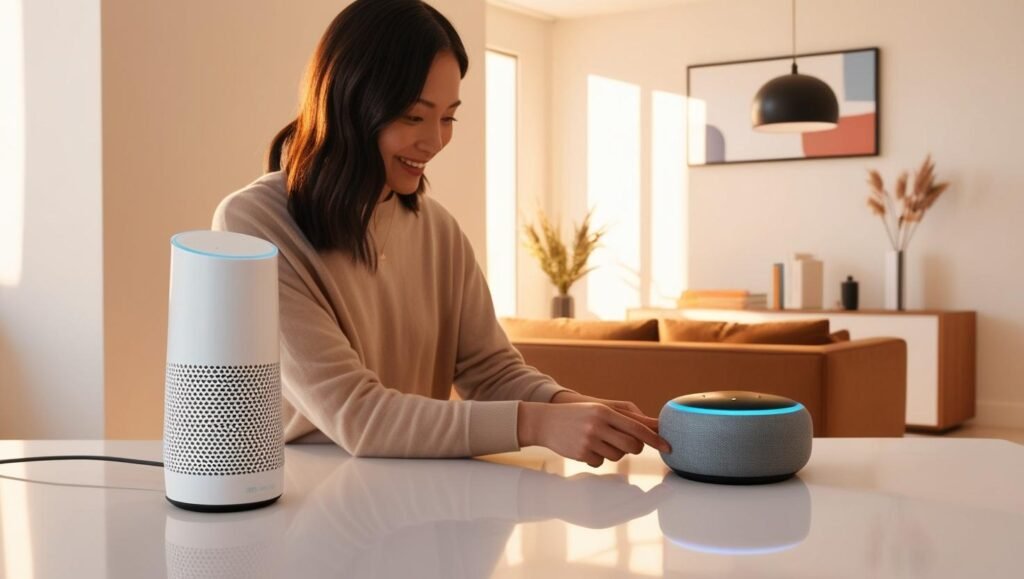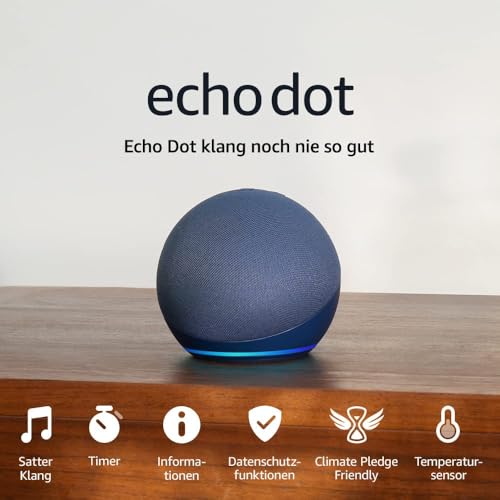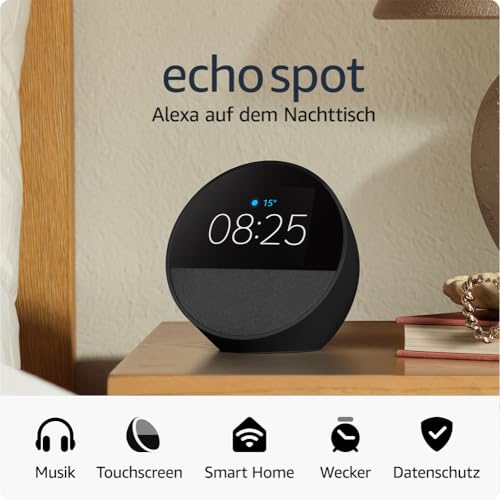
Introduction: Why Set Up a Voice Assistant at Home?
As technology continues to evolve, voice assistants have emerged as a pivotal element in modern smart homes. These intelligent systems, equipped with natural language processing capabilities, allow users to interact with their devices using simple voice commands. This hands-free convenience not only transforms everyday tasks but also streamlines the way individuals engage with their environments. By simply voicing a command, users can control various aspects of their home, from adjusting lighting to playing music, making the home a more user-friendly space.
The significance of voice assistants extends beyond mere convenience; they contribute significantly to time-saving capabilities. In a fast-paced world, multitasking has become essential. Voice assistants enable users to perform multiple functions simultaneously, enhancing productivity whether one is cooking, cleaning, or managing home entertainment. For instance, while preparing dinner, a user can ask their voice assistant to set a timer, provide a recipe, or even control the temperature in the living room, allowing them to focus on the task at hand.
Accessibility is another key benefit of setting up voice assistants at home. For those with mobility challenges or disabilities, these devices can serve as invaluable aids, granting them greater autonomy and control over their living spaces. Voice assistants can facilitate daily activities by providing reminders, making calls, and even assisting with home security functions. Their user-friendly interface makes them particularly appealing to beginners, requiring minimal technical knowledge to operate effectively. The growing popularity of voice assistants among novices highlights their potential to enhance everyday life, making hands-free living both practical and attainable.
In conclusion, the integration of voice assistants into homes marks a significant shift in how individuals manage their daily routines, offering unparalleled convenience and efficiency while promoting accessibility for all users.
- GROSSARTIGER KLANG: Die noch bessere Audioausgabe – klarere Stimmen, gewaltiger Bass – sorgt für ein immersives Echo Dot…
- MUSIK UND PODCASTS: Genieße Musik, Hörbücher und Podcasts von Amazon Music, Audible, Apple Music, Spotify und weiteren, …
- IMMER ZU DIENSTEN: Lass dir von Alexa sagen, wie das Wetter wird. Sie kann auch Timer stellen und Fragen beantworten, un…
Choosing the Right Voice Assistant for Your Home
When embarking on the journey of setting up voice assistants at home, the first step is to choose the right voice assistant that aligns with your needs and preferences. Several prominent options dominate the market, including Amazon Alexa, Google Assistant, and Apple Siri, each boasting unique features that cater to various requirements.
Amazon Alexa is known for its extensive compatibility with a myriad of smart devices, making it an attractive choice for those looking for a centralized hub for their smart home ecosystem. Alexa supports numerous third-party devices and offers skills through its app that can enhance functionality. This versatility allows users to customize their experience according to their specific needs.
In contrast, Google Assistant shines in its ability to leverage Google’s data and services, offering seamless integration with applications like Google Calendar and Google Maps. This makes it a compelling option for users who heavily rely on these services for daily planning and navigation. Moreover, Google Assistant is compatible with a wide array of smart home devices, providing significant flexibility when setting up voice assistants at home.
Apple Siri is particularly well-suited for those who are already invested in the Apple ecosystem. Siri’s integration with Apple devices such as the iPhone, iPad, and Mac provides a cohesive experience that is hard to replicate with other assistants. Furthermore, Siri’s focus on privacy sets it apart, appealing to users concerned about data security.
When choosing between these voice assistants, consider key factors such as device compatibility, personal ecosystem preferences, and price considerations. Assess whether your existing devices are compatible with the chosen assistant, and reflect on which ecosystem—Amazon, Google, or Apple—feels most familiar and supportive of your lifestyle. Balancing these considerations will ensure a smoother transition into the world of hands-free living.
- VALUE BUNDLE INCLUDES: Google Nest Mini 2nd Generation Bluetooth Speaker with English, Spanish, French and Portuguese Gl…
- IT WORKS EVERYWHERE Easy to use and will automatically start up in English when connecting to your device for the first …
- BLENDS RIGHT INTO YOUR HOME Looks great on a nightstand, shelf, countertop – or the wall. This Nest Mini Speaker is smal…
Hardware Options for Voice Assistants
When considering setting up voice assistants at home, the choice of hardware plays a crucial role in optimizing the overall experience. The most common devices that facilitate voice assistant functionality are smart speakers and smart displays. Some of the leading options available in the market include the Amazon Echo and Google Nest Mini for speakers, while the Echo Show and Nest Hub represent the smart display category.
Smart speakers, such as the Amazon Echo, offer a compact design and powerful sound quality, making them a popular choice for users seeking an affordable entry into hands-free living. These devices provide seamless integration with Alexa, allowing users to control their smart home devices, set reminders, play music, and access information simply through voice commands. The Google Nest Mini serves a similar purpose, showcasing the capabilities of Google Assistant, making it an excellent option for users who already rely on Google services.
On the other hand, smart displays like the Echo Show and Nest Hub provide the added advantage of visual feedback. These devices feature touchscreens that allow users to interact with their voice assistants in a more tactile way. With features such as video calling, live camera feeds, and recipe displays, they prove especially useful in kitchens and living spaces. Furthermore, they can serve as control centers for managing smart home devices, offering an intuitive interface for operations.
For those who prefer having a centralized control point, smartphones also play a vital role in setting up voice assistants at home. Both iOS and Android devices can serve as remote controls, enabling users to monitor and manage their smart devices from anywhere in their home. Ultimately, selecting the right hardware depends on individual preferences, budget considerations, and the envisioned level of interaction with voice assistants.
- Mit der Siri Remote (3. Generation) kannst du dein Apple TV 4K präzise steuern.
- Mit dem Touch basierten Clickpad kannst du Titel auswählen, durch Playlists streichen und eine Kreisgeste auf dem äußere…
- Mit Siri findest du, was du sehen möchtest, ganz einfach mit deiner Stimme.
Step-by-Step Guide to Setting Up a Voice Assistant
Setting up voice assistants at home can be an enjoyable process, providing users with hands-free control over various tasks. To begin, select your preferred voice assistant device, such as Amazon Echo, Google Nest, or Apple HomePod, and proceed with the following steps to ensure a streamlined installation.
First, unbox your device carefully, ensuring that all necessary components are included, such as the power adapter and any additional accessories. Once unboxed, place the device in a central location within your home for optimal performance. Next, connect the device to a power source using the provided adapter. Wait for the device to boot up, during which it will indicate readiness through an audio cue or visual signal.
The subsequent step involves downloading the corresponding app for your voice assistant on your smartphone or tablet. For Amazon Echo, download the Alexa app; for Google Nest, obtain the Google Home app; and for Apple HomePod, install the Apple Home app. After installation, create an account or log in if you already have one.
Once the app is open, follow the on-screen instructions to connect your voice assistant to your home Wi-Fi network. Selecting the correct network and entering the password is crucial for enabling cloud functionalities. After connecting to Wi-Fi, you may wish to pair your voice assistant with existing smart home devices, such as smart lights, thermostats, or security cameras. This can typically be done through the app’s settings and following the respective prompts.
After completing these interactions, test your voice assistant by issuing some basic commands. Try asking for the weather, playing music, or controlling a smart device to verify that everything is functioning correctly. By following these steps, setting up voice assistants at home can be a seamless experience, enhancing your daily activities through convenient, hands-free technology.
- ECHO POP – Der kompakte smarte Bluetooth-Lautsprecher mit Alexa bietet vollen Klang, der perfekt für das Schlafzimmer un…
- STEUERE DIE MUSIK MIT DEINER STIMME – Bitte Alexa einfach, Musik, Hörbücher und Podcasts von deinen Lieblingsanbietern a…
- MACH JEDEN RAUM SMART – Mit deiner Stimme oder der Alexa App kannst du ganz einfach deine kompatiblen smarten Geräte, wi…
Integrating Smart Home Devices with Voice Assistants
Integrating smart home devices with voice assistants is a significant step towards achieving a fully automated and convenient living space. Voice assistants such as Amazon Alexa, Google Assistant, and Apple Siri can streamline the control of various devices, including lights, plugs, thermostats, and security cameras, offering users a seamless experience in managing their home environment.
To begin the integration process, it is essential to ensure that your smart devices are compatible with your chosen voice assistant. Most major brands provide compatibility with these systems, so checking the manufacturer’s specifications can be helpful. For example, smart bulbs like Philips Hue can easily connect to voice assistants, allowing users to control lighting through simple voice commands. Commands such as “Turn on the living room lights” or “Set the bedroom light to 50% brightness” illustrate how intuitive managing lighting can be when utilizing these technologies.
In addition to basic command functions, users can create customized routines for a more enriched smart home experience. For instance, a morning routine could include commands such as “Good morning,” which can trigger the voice assistant to gradually brighten the lights, start the coffee maker, and adjust the thermostat to a comfortable temperature. This automation not only simplifies daily tasks but also enhances energy efficiency by controlling devices through thoughtful scheduling.
Moreover, security is a critical aspect of any smart home system. Integrating cameras or smart locks with voice assistants allows users to monitor their property hands-free. For instance, a command like “Show me the front door camera” can provide real-time surveillance directly to a smart display or mobile device. As voice assistants continue to evolve, the potential for integration with a wide array of smart home devices expands, paving the way for enhanced control and convenience in daily living.
- TRAVEL ANYWHERE IT WORKS GLOBALLY – It plugs into the wall and is powered by an adapter that works globally so it works …
- IT WORKS EVERYWHERE Easy to use and will automatically start up in English when connecting to your device for the first …
- BLENDS RIGHT INTO YOUR HOME Looks great on a nightstand, shelf, countertop – or the wall. This speaker is small and migh…
Creating Custom Commands and Routines
Setting up voice assistants at home allows users to enhance their daily lives with customized commands and routines tailored to individual needs. Creating personalized commands can significantly streamline daily tasks and elevate convenience. The voice assistant’s capability to execute specific actions in response to unique phrases empowers users to interact with their environment effortlessly. For example, a simple command like “Good night” can trigger a series of actions: dimming the lights, locking the doors, and playing soothing music. This routine exemplifies how voice technology can simplify the bedtime process.
Moreover, establishing a “Leaving Home” routine can assist in making sure all tasks are completed before you head out. This routine could include commands that turn off all smart lights, adjust the thermostat to energy-saving settings, and play an informative news brief while you gather your belongings. Routines like these help remind users to perform tasks that might otherwise be forgotten, enhancing productivity in daily life.
In addition to built-in commands, users can explore third-party services like IFTTT (If This Then That) for advanced customization options. IFTTT enables the automation of complex routines by linking different services and devices. For instance, one could create a command that, when issued, not only activates your coffee maker but also sends a notification to your smart fridge to prepare for the day’s meals. Integrating these services expands the potential of setting up voice assistants at home beyond their native functions, providing a more interconnected and responsive environment.
Overall, the combination of custom commands and routines enables a higher degree of interaction with voice assistants, allowing for a personalized and efficient home experience. With minimal effort, smart technology can transform repetitive daily tasks into streamlined activities, improving the overall quality of life.
- ECHO DOT KIDS – Unser beliebtester smarter Lautsprecher mit Alexa, für Kinder gestaltet (kein Spielzeug). Mit 1 Jahr alt…
- LERNEN UND SPASS – Kinder können Alexa bitten, Musik abzuspielen oder Gutenachtgeschichten vorzulesen. Alexa kann auch b…
- 1 JAHR AMAZON KIDS+-INHALTE INKLUSIVE – Eine digitale Mitgliedschaft, die ideal für Kinder zwischen 3 und 12 Jahren ist,…
Troubleshooting Common Issues During Setup
When setting up voice assistants at home, users may encounter a variety of common issues that could hinder the seamless experience these devices offer. One of the most prevalent problems is connectivity issues. Ensuring a stable internet connection is vital for voice assistants to function correctly. Users should check that their Wi-Fi network is active and that the device is within the required range of the router. If persistent issues arise, restarting the router or the voice assistant can often resolve the connectivity problems.
Another challenge often reported during the initial setup phase is related to voice recognition. Devices may struggle to understand commands, which can be particularly frustrating for new users. To enhance voice recognition, it is advisable to conduct the setup in a quiet environment, away from loud noises or background discussions. Furthermore, users should practice speaking clearly and at a moderate pace when giving commands. Adjusting the voice assistant’s settings to recognize different accents or dialects may also improve performance.
Software updates play a significant role in the performance of voice assistants at home. Outdated firmware can lead to malfunctions during setup, affecting features or functionalities. Users should check for available software updates regularly and ensure that their devices are running the latest version. This not only improves overall performance but also secures the device against potential vulnerabilities. If updates are not installing, users can try restarting the device or rechecking their internet connection.
By addressing these common issues—connectivity lapses, voice recognition difficulties, and necessary software updates—users can significantly enhance their experience with voice assistants. These troubleshooting tips will help streamline the setup process, paving the way for a more efficient and enjoyable hands-free living environment.
- BESSER, INNEN UND AUSSEN – Entertainment wird durch 3D-Audio und einen 8-Zoll-HD-Touchscreen noch immersiver. Videogespr…
- LEBENDIGES BILD, VOLLWERTIGER KLANG – Inhalte auf Prime Video, Netflix und vielen weiteren Plattformen erwachen mit dem …
- SMART HOME LEICHT GEMACHT – Mit Zigbee, Matter und Thread kompatible Geräte lassen sich ohne separaten Smart-Home-Hub ko…
Practical Use Cases for Voice Assistants
Voice assistants have become an integral part of modern households, significantly simplifying everyday tasks through hands-free technology. One of the primary functions of these devices is to assist with reminders and scheduling. Users can effortlessly set reminders by simply speaking commands, thus managing their daily routines without the need to manually update calendars or note tasks. This capability not only saves time but also ensures that important appointments and deadlines are not forgotten.
In addition to reminders, voice assistants excel at creating and managing shopping lists. With just a few vocal commands, individuals can add items to their grocery lists, which can be accessed later on their smartphones or through compatible apps. This feature enhances shopping efficiency, allowing users to focus on other activities while ensuring they have everything they need when they visit the store.
Entertainment is another area where voice assistants shine. Users can seamlessly control their music playback, ask for song recommendations, and even request information about their favorite artists, all through voice commands. This hands-free operation transforms the way people engage with music and media, providing a more enjoyable experience.
Furthermore, voice assistants play a vital role in accessibility for individuals with disabilities. For those with mobility impairments or visual challenges, voice-controlled devices enable access to information and control of home environments, making daily life more manageable and independent.
Home security is also enhanced through the use of voice assistants. By integrating smart home devices like security cameras and alarms, users can monitor and control their home security systems with voice commands. This functionality offers peace of mind, allowing homeowners to manage their safety effortlessly.
As demonstrated, setting up voice assistants at home can greatly enhance efficiency and accessibility, providing practical solutions for a wide range of everyday tasks and needs.
- ECHO SPOT – Ein stylischer smarter Wecker mit Alexa, der mit großartigem Klang begeistert. Dein idealer Begleiter beim A…
- PERSONALISIERBARE SMART CLOCK – Lies Uhrzeit, Wettervorhersage und Songtitel direkt vom Display ab, steuere Smart-Home-G…
- GROSSARTIGER KLANG – Satter Klang, klare Stimmen und tiefe Bässe. Bitte Alexa einfach, Musik, Hörbücher oder Podcasts vo…
Tips for Securing Your Voice Assistant
Setting up voice assistants at home can enhance convenience; however, it also raises certain security concerns that should be appropriately addressed. To ensure the safe usage of your voice assistant, it is crucial to implement robust security measures. One effective method is to utilize multi-user profiles, which leverage voice recognition technology. By registering unique voice profiles for different users, each person can access their personalized settings while maintaining a level of privacy. This differentiation helps protect personal information from being inadvertently accessed by others in the household.
Another essential step is enabling two-factor authentication (2FA) for any linked accounts associated with your voice assistant. Many voice assistants allow integration with smart home devices, music services, and other applications. By setting up 2FA, you add an additional layer of security. This means that even if someone obtains your password, they would still need a secondary verification method, such as a code sent to your phone, to gain access to your accounts. This significantly reduces the risk of unauthorized access to your personal data and connected devices.
Moreover, it is prudent to regularly review the voice recordings stored by your assistant. Most voice assistants allow users to access and manage their voice history. Evaluating these recordings ensures that you are aware of the information being collected and stored. If any recordings seem unnecessary or concerning, they can be deleted to uphold your privacy. Regular scrutiny of voice data not only protects your personal information but also informs you about potential voice assistant miscommunications. By adopting these measures, users can elevate their security while enjoying the conveniences of hands-free living.
- ERLEBE IMMERSIVEN KLANG – Echo Studio bietet jetzt 3D-Audioverarbeitungstechnologie, für ein immersiveres Audio-Erlebnis…
- STEUERE DEINE MUSIK MIT DEINER STIMME – Streame Songs von Amazon Music, Apple Music, Spotify, Deezer und weiteren. Mit A…
- PASST SICH AN JEDEN RAUM AN – Echo Studio erfasst automatisch die Akustik deines Raums und passt die Wiedergabe entsprec…
Conclusion: Embrace Hands-Free Living
In recent years, the popularity of voice assistants has grown significantly, and for good reason. Setting up voice assistants at home offers an array of benefits that enhance convenience, efficiency, and overall quality of life. These smart devices allow users to control various functionalities of their homes simply by using their voice, making everyday tasks more manageable. Whether searching for recipes, adjusting the thermostat, or controlling lights, incorporating voice-activated technology simplifies the way we interact with our living spaces.
The transition to a hands-free living experience can be a gradual process. Beginners are encouraged to start with a single device such as a smart speaker or a voice-controlled hub. This initial step not only provides an opportunity to become familiar with the technology but also creates a foundation to build upon. As users become comfortable with their first voice assistant, they can expand their setup by adding complementary devices like smart bulbs, security systems, and appliances that integrate with their existing assistant.
Choosing the right voice assistant is crucial to maximizing benefits. Each platform offers unique features and compatibility with different smart home devices. By evaluating personal needs and preferences, users can select the most suitable assistant to enhance their daily routines. Exploring the capabilities and functionalities of these systems will reveal the potential for smarter home living.
In conclusion, the journey towards a smarter home through setting up voice assistants at home is both accessible and rewarding. Embracing hands-free living not only brings convenience but also opens the door to numerous opportunities for improving home life. Start today by selecting a voice assistant and unlock the myriad possibilities for innovative living. Your hands-free future awaits!








